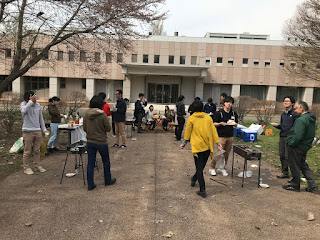Probably a way overdue post, with my current procrastination rate as well as addiction to Mobile Legends, I barely have any motivation to continue my blog posts.
So fans of Japan always have a must-do in their bucket list, which is Hanami aka Flower Viewing during the full bloom seasons of sakura aka cherry blossom.
While the main island aka Honshu blooms relative early each year, mostly around April for most of the area, Hokkaido or the northern islands bloom much later, for this year the full bloom was on the last week of April. I was extremely excited to experience my first Hanami, simply because all the past visits of mine to Japan were any time BUT April. No thanks to my academic calendar, and all the mid term tests scheduled on the same period for the past 6 years. To those who are interested you can always check here for the forecast.
I'm pretty lucky I would say because Hokkaido University aka Hokudai is an agricultural based university where landscaping plays an important role in the grand design of the campus. In Sapporo campus, almost all faculties have at least one cherry blossom tree grown around the yard. After a stroll around the campus, I came to a conclusion that my faculty, the Faculty of Veterinary Medicine of Hokudai instead has the most beautiful sakura tree in the whole campus. I definitely do recommend people to drop by to have a great shot here because the view is simply amazing.
In our teaching hospital, it was customary to hold a Hanami Gingpa (short term for Gengkhin Khan Party, or basically barbecue) when it comes to the season of spring. The 5th years will be in charge in organizing everything where the 6 years and PhD students will try to help as much as we can to make the party a success.
This was the view before the full bloom
This was the view on the full bloom of the tree in our faculty, arguable the best!
Apart from the party we had in our faculty, I also went to an area north-east to Sapporo for another sakura viewing with my Japanese friend and fellow Hokudai MEXT scholar Thari.
This was in Shizunai (静内), where there's a passage of sakura up to 2km, but due to the rainy season some parts were sealed off for safety purposes.
Shizunai is well known for its stud farms, where some deceased horses even has a sakura tree grown over their bodies as memorials
To my surprise my professor was also there with his family, and he was the one who noticed me when I was strolling my way past the streets of the vendors. I should have taken a photo with him, maybe I should be more proactive around him in the future.
Later on, we went up further to Urakawa (浦河) for another site of sakura viewing, only to be disappointed with the constant drizzling, where we ended up having the picnic in our rented car instead. Nevertheless, we managed to nab one picture before we left thanks to the kind photo enthusiast who saw me struggling with the self timer.
Our day ended with an awesome seafood feast near the town of Tomakomai (苫小牧) where the place is extremely famous for their affordable fresh seafood. We spent about 4000yen per person but the food was famishing good, which I think the money was well spent. I don't remember each dish's name but I'm definitely going there again.
Despite spending my first month in Hokkaido, I actually managed to go around quite a lot. I'll try to motivate myself to post more from now on, so my blog will come alive again.
Honestly, I really wish my English wouldn't go down the drain after all these years of cultivation.

























